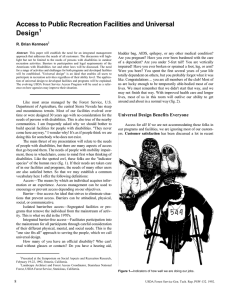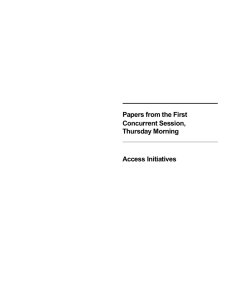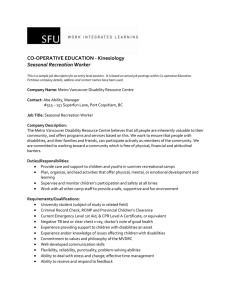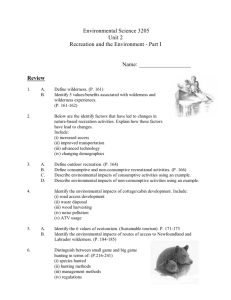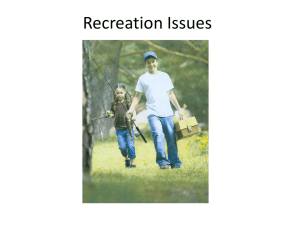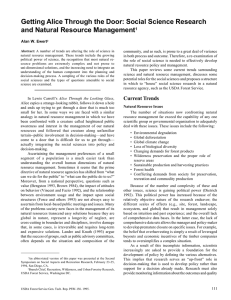Document 11232452
advertisement
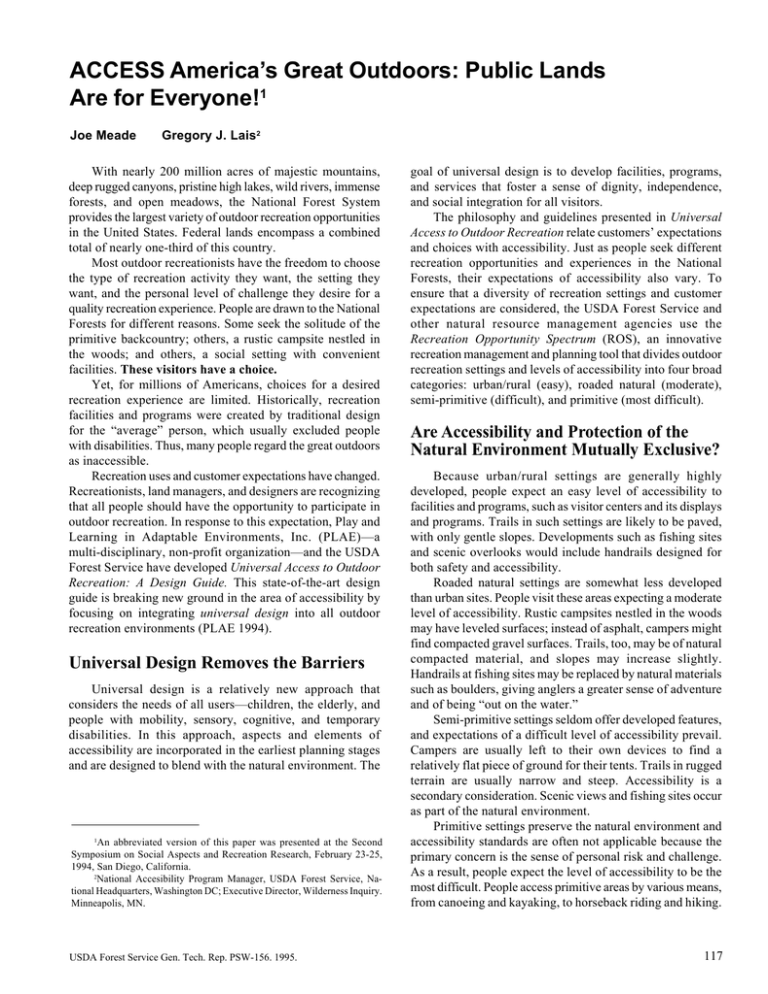
ACCESS America’s Great Outdoors: Public Lands Are for Everyone!1 Joe Meade Gregory J. Lais2 With nearly 200 million acres of majestic mountains, deep rugged canyons, pristine high lakes, wild rivers, immense forests, and open meadows, the National Forest System provides the largest variety of outdoor recreation opportunities in the United States. Federal lands encompass a combined total of nearly one-third of this country. Most outdoor recreationists have the freedom to choose the type of recreation activity they want, the setting they want, and the personal level of challenge they desire for a quality recreation experience. People are drawn to the National Forests for different reasons. Some seek the solitude of the primitive backcountry; others, a rustic campsite nestled in the woods; and others, a social setting with convenient facilities. These visitors have a choice. Yet, for millions of Americans, choices for a desired recreation experience are limited. Historically, recreation facilities and programs were created by traditional design for the “average” person, which usually excluded people with disabilities. Thus, many people regard the great outdoors as inaccessible. Recreation uses and customer expectations have changed. Recreationists, land managers, and designers are recognizing that all people should have the opportunity to participate in outdoor recreation. In response to this expectation, Play and Learning in Adaptable Environments, Inc. (PLAE)—a multi-disciplinary, non-profit organization—and the USDA Forest Service have developed Universal Access to Outdoor Recreation: A Design Guide. This state-of-the-art design guide is breaking new ground in the area of accessibility by focusing on integrating universal design into all outdoor recreation environments (PLAE 1994). Universal Design Removes the Barriers Universal design is a relatively new approach that considers the needs of all users—children, the elderly, and people with mobility, sensory, cognitive, and temporary disabilities. In this approach, aspects and elements of accessibility are incorporated in the earliest planning stages and are designed to blend with the natural environment. The 1 An abbreviated version of this paper was presented at the Second Symposium on Social Aspects and Recreation Research, February 23-25, 1994, San Diego, California. 2 National Accesibility Program Manager, USDA Forest Service, Na­ tional Headquarters, Washington DC; Executive Director, Wilderness Inquiry. Minneapolis, MN. USDA Forest Service Gen. Tech. Rep. PSW-156. 1995. goal of universal design is to develop facilities, programs, and services that foster a sense of dignity, independence, and social integration for all visitors. The philosophy and guidelines presented in Universal Access to Outdoor Recreation relate customers’ expectations and choices with accessibility. Just as people seek different recreation opportunities and experiences in the National Forests, their expectations of accessibility also vary. To ensure that a diversity of recreation settings and customer expectations are considered, the USDA Forest Service and other natural resource management agencies use the Recreation Opportunity Spectrum (ROS), an innovative recreation management and planning tool that divides outdoor recreation settings and levels of accessibility into four broad categories: urban/rural (easy), roaded natural (moderate), semi-primitive (difficult), and primitive (most difficult). Are Accessibility and Protection of the Natural Environment Mutually Exclusive? Because urban/rural settings are generally highly developed, people expect an easy level of accessibility to facilities and programs, such as visitor centers and its displays and programs. Trails in such settings are likely to be paved, with only gentle slopes. Developments such as fishing sites and scenic overlooks would include handrails designed for both safety and accessibility. Roaded natural settings are somewhat less developed than urban sites. People visit these areas expecting a moderate level of accessibility. Rustic campsites nestled in the woods may have leveled surfaces; instead of asphalt, campers might find compacted gravel surfaces. Trails, too, may be of natural compacted material, and slopes may increase slightly. Handrails at fishing sites may be replaced by natural materials such as boulders, giving anglers a greater sense of adventure and of being “out on the water.” Semi-primitive settings seldom offer developed features, and expectations of a difficult level of accessibility prevail. Campers are usually left to their own devices to find a relatively flat piece of ground for their tents. Trails in rugged terrain are usually narrow and steep. Accessibility is a secondary consideration. Scenic views and fishing sites occur as part of the natural environment. Primitive settings preserve the natural environment and accessibility standards are often not applicable because the primary concern is the sense of personal risk and challenge. As a result, people expect the level of accessibility to be the most difficult. People access primitive areas by various means, from canoeing and kayaking, to horseback riding and hiking. 117 One important point to remember is that all developed structural elements—restrooms, water hydrants, picnic tables, and cooking units—will be designed to meet full accessibility standards at all sites. Who Benefits? More than half the American population will benefit from campgrounds, restrooms, trails, and other visitor facilities and programs that are designed with access for everyone: • • • One in 5 Americans (43 million) experiences a disability One in 10 Americans (25 million) is temporarily disabled at any one time Nearly 1 in 3 older Americans (11.2 million of the 30 million people over age 65) has a disability. In addition, if one family member cannot participate, most likely the entire family will be affected. So the initial figure of 43 million is actually just the beginning. Thus, the number of people directly benefiting from universal design can easily be multiplied three or four times. What’s on the Horizon? In addition to facilities and activities, universal design should be integrated into all programs and services. This integration will benefit all ages, abilities and cultures, as well as increase customer satisfaction. Individuals visiting an interpretive center or a visitor station expect and desire equal access to the information and services offered there. Information should be available in a variety of formats: visual, audible and tactile. Programs should be offered with options that allow for the greatest range of participation. The need for programmatic access underscores the importance of ensuring that service providers are sensitive to the needs of persons with disabilities and understand the vital importance of providing this access. Training and exposure to the issues and concerns of universal access is critical. Universal design improves the program and service for everyone. Collaboration American institutions are being encouraged and compelled to combine resources with other agencies for collaborative projects. The USDA Forest Service has developed several partnerships related to universal access which demonstrate that the whole is greater than the sum of the parts. One example of this is the Universal Design Short Course. For this partnership, the Forest Service formed a team with Wilderness Inquiry, Inc., a non-profit travel organization serving people with and without disabilities on wilderness adventures throughout the world, and the University of Minnesota, a land-grant university. The short course offered an intense exposure to universal design and presented guidelines on integrating it into the outdoor recreation environment. By acquiring personal experience, 118 course participants developed the understanding that universal design is the only design approach that makes sense in a democratic society. The Forest Service has also established a partnership with Wilderness Inquiry, Inc., and America Outdoors, an association of trade outfitters. Through this challenge cost-share agreement, the outfitter industry and the Federal public land management agencies have developed a handbook to assist outfitters and guides in providing universal access to their programs and services (National Council on Disability 1992). Currently the American Ski Federation (AFS) has collaborated with the USDA Forest Service to develop access guidelines for the ski industry. This effort reflects not only a legal response to requirements of the Americans with Disabilities Act, but also the industry’s view that providing accessible facilities makes good business sense. Developing guidelines together will create workable solutions that focus on quality customer service. Quickie Designs, a manufacturer of ultra-light outdoor recreation sport equipment for people with mobility disabilities, has formed a partnership with the USDA Forest Service and Wilderness Inquiry’s state-of-the-art technology for accessing America’s Great Outdoors.3 These examples of partnerships underscore the fact that agencies do not need to have or develop expertise in every area. However, they do need to know where to find specific skills and how to develop effective partnerships that will make the best use of that expertise. Accessing the Wilderness Another partnership involving the National Council on Disability and Wilderness Inquiry Inc. produced a Congressionally mandated report on Wilderness Accessibility for People with Disabilities. This study, presented to the President and Congress, focused on lands managed under the National Wilderness Preservation System (NWPS). The report concluded that people with disabilities were as concerned with protecting the integrity of the wilderness as non-disabled individuals; accessibility should be a secondary consideration to the preservation and protection of the environment in the NWPS. The report also contained several recommendations to Congress related to the need for adopting policies that are consistent with Section 507c of the Americans with Disabilities Act, such as developing guidelines for special permits and modifications that are consistent with the Wilderness Act; conducting trainings for NWPS managers to raise awareness of disabilities issues and use of NWPS by people with disabilities; and providing information to the 3 Trade names and commercial enterprises or products are mentioned solely for information. No endorsement by the U.S. Department of Agricul­ ture is implied. USDA Forest Service Gen. Tech. Rep. PSW-156. 1995. public about recreation opportunities in the NWPS for people with disabilities. A significant majority of persons with disabilities surveyed in the report enjoy the NWPS. Further, 76 percent of those surveyed do not believe that the restrictions on mechanized use stated by the Wilderness Act diminish their enjoyment. People with disabilities visit the NWPS in the same ways and for the same reasons that people without disabilities visit the NWPS. much additional research is needed. Two critical issues that warrant further study are: the social expectations of consumers of accessible recreation in the diversity of recreation settings; the energy consumption and physical capabilities required to utilize the universal design guidelines being established for outdoor recreation environments. Conclusion National Council on Disability. 1992. Wilderness Accessibility for People With Disabilities, Washington, DC: Wilderness Inquiry; 108 p. Play and Learning in Adaptable Environments (PLAE) 1994. Universal Access to Outdoor Recreation: A Design Guide. Berkeley, CA: MIG Communications; 240 p. The ideals we have described are based on broad input from consumers of accessible outdoor recreation. However, USDA Forest Service Gen. Tech. Rep. PSW-156. 1995. References 119

